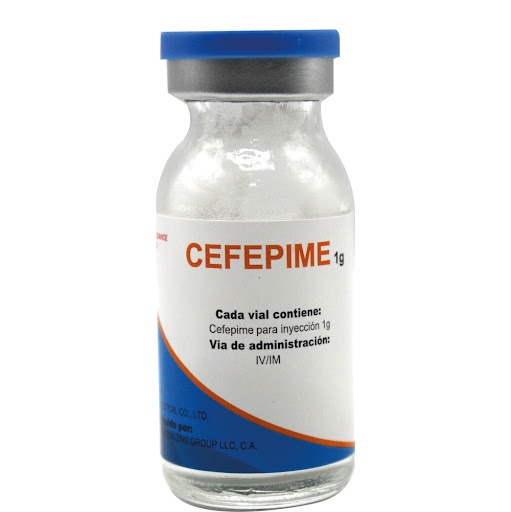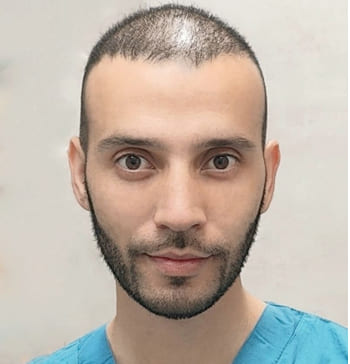

ЦЕФЕПІМА САЛА 1 г ПОРОШОК ДЛЯ ПРИГОТУВАННЯ РОЗЧИНУ ДЛЯ ІН'ЄКЦІЙ ТА ДЛЯ ІНФУЗІЙ

Запитайте лікаря про рецепт на ЦЕФЕПІМА САЛА 1 г ПОРОШОК ДЛЯ ПРИГОТУВАННЯ РОЗЧИНУ ДЛЯ ІН'ЄКЦІЙ ТА ДЛЯ ІНФУЗІЙ

Інструкція із застосування ЦЕФЕПІМА САЛА 1 г ПОРОШОК ДЛЯ ПРИГОТУВАННЯ РОЗЧИНУ ДЛЯ ІН'ЄКЦІЙ ТА ДЛЯ ІНФУЗІЙ
Вступ
Опис: інформація для користувача
Цефепім Сала 1г порошок для ін'єкційного та перфузійного розчину ЕФГ
Перш ніж почати використовувати цей лікарський засіб, уважно прочитайте весь опис, оскільки він містить важливу інформацію для вас.
- Збережіть цей опис, оскільки вам може знадобитися знову його прочитати. - Якщо у вас виникли питання, проконсультуйтеся з лікарем, фармацевтом або медсестрою.
- Якщо ви відчуваєте побічні ефекти, проконсультуйтеся з лікарем, фармацевтом або медсестрою, навіть якщо це побічні ефекти, які не вказані в цьому описі. Див. розділ 4.
Зміст опису
- Що таке Цефепім Сала і для чого він використовується
- Що вам потрібно знати перед тим, як почати використовувати Цефепім Сала
- Як використовувати Цефепім Сала
- Можливі побічні ефекти
- Зберігання Цефепім Сала
- Зміст упаковки та додаткова інформація
1. Що таке Цефепім Сала і для чого він використовується
Цефепім Сала містить активну речовину цефепім.
Цефепім належить до групи антибіотиків, званих цефалоспоринами, які діють шляхом знищення бактерій.

Цефепім використовується, коли інфекція викликана бактеріями, чутливими до цефепіму. Він використовується для лікування наступних інфекцій:
- інфекцій легень, таких як пневмонія,
- інфекцій в репродуктивній системі (у дорослих), в сечовидільній системі та нирках,
- інфекцій шкіри,
- інфекцій в абдомені,
- інфекцій в кровотоці, викликаних бактеріями (бактеріємія),
- інфекції в мозку та спинному мозку у дітей (менінгіт),
- інфекцій у пацієнтів з зниженням кількості лейкоцитів (нейтропенія)
2. Що вам потрібно знати перед тим, як почати використовувати Цефепім Сала
Не використовуйте Цефепім Сала
- якщо ви алергічні на цефепім або на будь-який інший компонент цього лікарського засобу (перелічені в розділі 6).
Попередження та обережність
Проконсультуйтеся з лікарем, фармацевтом або медсестрою перед тим, як почати використовувати цефепім:
- Якщо у вас є проблеми з нирками.
- Якщо ви алергічні на щось, не вказане в цьому описі.
- Якщо ви раніше мали проблеми з кишківником, зокрема коліт (запалення кишківника).
- Якщо ви пацієнт похилого віку.
Використання цефепіму з іншими лікарськими засобами
Повідомте свого лікаря або медсестру, якщо ви приймаєте, нещодавно приймали або можете приймати будь-який інший лікарський засіб. Це включає лікарські засоби, придбані без рецепта, та лікарські засоби на основі рослин. Це тому, що цефепім може впливати на дію інших лікарських засобів. Також інші лікарські засоби можуть впливати на дію цефепіму.
Особливо повідомте свого лікаря або медсестру, якщо ви приймаєте будь-який з наступних лікарських засобів:
- Аміноглюкозиди або інші антибіотики (використовуються для лікування інфекцій)
- Антикоагулянти (лікарські засоби для розрідження крові)
Також вам потрібно повідомити свого лікаря або медсестру, якщо ви проходите аналіз крові або сечі.
Вагітність та лактація
Якщо ви вагітні або в період лактації, вважаєте, що можете бути вагітні або плануєте завагітніти, проконсультуйтеся з лікарем або фармацевтом перед тим, як використовувати цей лікарський засіб.
Водіння транспортних засобів та використання машин
Не проводилися дослідження щодо впливу на здатність водити транспортні засоби та використовувати машини.
Не водьте транспортні засоби та не використовуйте машини, якщо ви не впевнені, що це не впливає на вас.
3. Як використовувати Цефепім Сала
Лікар або медсестра введуть вам цей лікарський засіб. Він буде введений одним з наступних способів:
- У вигляді ін'єкції в м'яз (наприклад, м'яз руки).
- Повільною ін'єкцією в одну з ваших вен. Цей процес може тривати від 3 до 5 хвилин.
- Через малий трубку в одну з ваших вен. Це називається внутрішньовенною перфузією. Зазвичай, тривалість становить не менше 30 хвилин.
Зазвичай, вам буде введено Цефепім Сала протягом 7-10 днів, залежно від типу інфекції, яку ви маєте.
Дорослі та пацієнти похилого віку
Нормальна доза становить 500 мг (міліграм) до 1г (грам) кожні 12 годин. Якщо у вас є важка інфекція, лікар може призначити вищу дозу, до 2 г кожні 8 годин.
Використання у дітей та підлітків
Доза обчислюється лікарем на основі ваги тіла.
- У дітей старших 2 місяців та з вагою нижче 40 кг, звичайна доза становить 50 мг на кг ваги тіла кожні 12 годин. залежно від типу та тяжкості інфекції, можна призначити дози кожні 8 годин.
- У дітей молодших 2 місяців можна призначити дозу 30 мг на кг ваги тіла кожні 12 годин
- Для дітей, які важать більше 40 кг, можна використовувати дозу для дорослих
- Максимальна доза у дітей не повинна перевищувати 2 г кожні 8 годин
Пацієнти з проблемами нирок
Якщо у вас є проблеми з нирками, вам буде призначено нижчу дозу. Можливо, вам потрібно буде пройти аналіз крові, щоб перевірити, чи ви отримуєте необхідну дозу.
Якщо ви використовуєте більше Цефепім Сала, ніж потрібно
Якщо ви вважаєте, що отримали надто багато Цефепім Сала, повідомте свого лікаря або медсестру.
У разі передозування або випадкового прийому проконсультуйтеся з лікарем або фармацевтом або зверніться до Токсикологічної служби, телефон: 91 562 04 20, вказавши лікарський засіб та кількість, прийняту.
Якщо у вас є будь-які інші питання щодо використання цього лікарського засобу, запитайте свого лікаря або медсестру
4. Можливі побічні ефекти
Як і всі лікарські засоби, цей лікарський засіб може викликати побічні ефекти, хоча не всі люди їх відчувають.
Важкі алергічні реакції(рідко, можуть впливати на менше 1 з 1000 осіб)
Якщо у вас є важка алергічна реакція, повідомте своєму лікарю негайно.
Симптоми можуть включати:
- Раптове набухання обличчя, горла, губ та рота. Це може зробити для вас важким дихання або ковтання.
- Раптове набухання рук, ніг та стоп.
Інші можливі побічні ефекти:
Дуже часті:можуть впливати на більше 1 з 10 осіб
- Позитивні результати тесту Кумбса (аналіз для деяких проблем з кров'ю)
Часті:можуть впливати на до 1 з 10 осіб
- Проблеми з згортанням крові. Симптоми включають легке утворення синяків
- Анемія, яка може зробити вас блідим, відчувати втому та нестачу дихання
- Запалення, біль або відчуття печіння в місці ін'єкції
- Діарея
- Проблеми з печінкою, наприклад, жовтяниця та зміни в печінкових ферментах у крові
- Висип
Рідко:можуть впливати на до 1 з 100 осіб
- Інфекція, викликана дріжджами, в роті
- Вагінальні інфекції
- Зміни в кількості лейкоцитів у вашій крові. Симптоми включають раптове підвищення температури тіла (лихоманка), озноб та біль у горлі
- Головний біль
- Запалення товстої кишки (колон). Симптоми включають діарею, зазвичай з кров'ю та слизом, біль у животі та лихоманку
- Нудота та блювота
- Кропив'янка, відчуття свербіння та червоність шкіри
- Проблеми з нирками (які можна спостерігати в аналізі крові)
- Лихоманка
Рідко:можуть впливати на до 1 з 1000 осіб
- Інфекції, викликані грибами
- Поколювання та відчуття оніміння в тілі
- Вертігі, з судомами (конвульсії)
- Відчуття труднощів з диханням
- Біль у животі, запор
- Відчуття холоду та ознобу
- Свербіння в геніталіях
Частота невідома:частота не може бути обчислена з доступних даних
- Деякі види анемії (гемолітична анемія або апластична анемія)
- Хибні позитивні результати аналізу глюкози в сечі
- Збентеження, галюцинації
- Втрата свідомості, порушення мозкової діяльності
- Проблеми з нирками
- Важкий висип на шкірі з виразками в роті, болем у суглобах та болем в очах
Повідомлення про побічні ефекти
Якщо ви відчуваєте будь-який побічний ефект, повідомте своєму лікарю, фармацевту або медсестрі, навіть якщо це можливі побічні ефекти, які не вказані в цьому описі. Також ви можете повідомити про них безпосередньо через Систему моніторингу лікарських засобів: www.notificaRAM.es . Надсилаючи повідомлення про побічні ефекти, ви можете допомогти надати більше інформації про безпеку цього лікарського засобу.
5. Зберігання Цефепім Сала
Ваш лікар або фармацевт відповідає за зберігання цього лікарського засобу.
Тримайте цей лікарський засіб поза зоною досяжності дітей.
Не використовуйте цей лікарський засіб після закінчення терміну придатності, вказаного на упаковці, після CAD.
Не відкрито
Не потрібно спеціальних умов зберігання. Тримайте флакон в зовнішній упаковці, щоб захистити його від світла.
Після відкриття
Продукт повинен бути використаний негайно після відкриття.
Перевідний продукт
Внутрішньом'язова ін'єкція
Вода для ін'єкційних препаратів, хлорид натрію 9 мг/мл (0,9 %), глюкоза 50 мг/мл ( 5% ) та
лідокаїн 5 мг/мл (0,5 %)
Встановлено хімічну та фізичну стабільність під час використання протягом 2 годин при 25± 5°C або протягом 24 годин при температурі не вище 2-8°C.
З мікробіологічної точки зору, продукт повинен бути введений негайно. Якщо він не буде введений негайно, умови та терміни зберігання під час використання, перед його використанням, є відповідальністю користувача та зазвичай не повинні перевищувати 24 години при 2-8 °C, якщо тільки реконструкція/розбавлення не проводилася під контролем та у валідахованих асептичних умовах.
Внутрішньовенна ін'єкція
Вода для ін'єкційних препаратів, хлорид натрію 9 мг/мл (0,9 %) та глюкоза 50 мг/мл ( 5% )
Встановлено хімічну та фізичну стабільність під час використання протягом 2 годин при 25± 5°C або протягом 24 годин при температурі не вище 2-8°C.
З мікробіологічної точки зору, продукт повинен бути введений негайно. Якщо він не буде введений негайно, умови та терміни зберігання під час використання, перед його використанням, є відповідальністю користувача та зазвичай не повинні перевищувати 24 години при 2-8 °C, якщо тільки реконструкція/розбавлення не проводилася під контролем та у валідахованих асептичних умовах.
Лікарські засоби не повинні бути викинуті у каналізацію чи сміття. Спитайте свого фармацевта, як позбутися упаковок та лікарських засобів, які вам не потрібні. Таким чином, ви допоможете захистити навколишнє середовище.
6. Зміст упаковки та додаткова інформація
Склад Цефепіми Сала
- Активний інгредієнт - цефепім (у вигляді моногідрату дигідрохлориду).
- Кожна флакон містить 1г цефепіму (у вигляді моногідрату дигідрохлориду).
- Інші компоненти: аргінін.
Вигляд продукту та вміст упаковки
Цефепім Сала - це порошок. Його колір - білий до світло-жовтого.
Він упакований у скляному флаконі Tipo I об'ємом 20 мл, закритому гумовою пробкою з бромобутилу та алюмінієвою кришкою.
Продукція випускається в упаковках по 1 або 50 флаконів.
Не всі розміри упаковок можуть бути в продажу.
Власник дозволу на продаж
Лабораторія Reig Jofré, SA
Gran Capitan 10, 08970
Сант-Хоан-Деспі – Барселона, Іспанія
Виробник
Лабораторія Reig Jofré, S.A.
C/ Jarama, 111, Промислова зона – 45007 Толедо, Іспанія
Дата останнього перегляду цього проспекту: Травень 2016
“Детальна та актуальна інформація про цей лікарський засіб доступна на сайті Іспанського агентства з лікарських засобів та медичних продуктів (http://www.aemps.gob.es)<---------------------------------------------------------------------------------------------------------
Ця інформація призначена лише для медичних працівників:
Цефепім Сала 1 г порошок для ін'єкційного та перфузійного розчину EFG
Дозування та спосіб застосування
Може застосовуватися внутрішньовенно та внутрішньом'язово
Перевага надається внутрішньовенному застосуванню у пацієнтів з тяжкими або потенційно смертельними інфекціями, особливо коли існує ризик шоку.
До застосування необхідно відновити розчин. Відновлений розчин має білий або легкий жовтий колір. Розчин повинен бути прозорим та вільним від видимих частинок.
Дозування та спосіб застосування цефепіму залежать від типу та тяжкості інфекції, чутливості мікроорганізму, функції нирок та загального стану пацієнта.
Дорослі з нормальною функцією нирок
Відповідно до наступної таблиці:
Тяжкість інфекції | Дозування та спосіб застосування | Інтервал між дозами |
Легкі та середньої тяжкості інфекції сечовидільної системи. | 500 мг або 1 г внутрішньовенно або внутрішньом'язово | Кожні 12 годин |
Інші легкі або середньої тяжкості інфекції (крім інфекцій сечовидільної системи) | 1 г внутрішньовенно або внутрішньом'язово | Кожні 12 годин |
Тяжкі інфекції | 2 г внутрішньовенно | Кожні 12 годин |
Інфекції, що загрожують життю або дуже тяжкі | 2 г внутрішньовенно | Кожні 8 годин |
Тривалість лікування зазвичай становить 7-10 днів; однак у разі тяжких інфекцій може бути необхідне тривале лікування. Для емпіричного лікування нейтропенії тривалість лікування зазвичай становить 7 днів або до моменту відновлення нейтропенії.
У пацієнтів з масою тіла менше 40 кг рекомендується дозування для дітей.
Дорослі з порушенням функції нирок
Необхідно коригувати дозування цефепіму для компенсації зниженної швидкості виділення нирками. У дорослих пацієнтів з легким або середнім порушенням функції нирок рекомендується початкова доза цефепіму така ж, як у пацієнтів з нормальною функцією нирок. Рекомендована підтримуюча доза повинна бути згідно з інструкціями таблиці нижче.
Для оцінки кліренсу креатиніни можна використовувати наступну формулу (Gault і Cockcroft) лише тоді, коли креатинін сироватки доступний. Креатинін сироватки повинен відображати стабільний стан функції нирок:
Чоловіки: Кліренс креатиніну (мл/хв) = Маса (кг) х (140 – вік)
72 х креатинін сироватки (мг/дл)
Жінки: 0,85 х розрахункове значення, отримане за формулою для чоловіків
Кліренс креатиніну (мл/хв) | Рекомендована підтримуюча доза | |||
> 50 | Звичайна доза. Коригування дози не потрібно | |||
2 г, 3 рази на добу | 2 г, 2 рази на добу | 1 г, 2 рази на добу | 500 мг, 2 рази на добу | |
30-50 | 2 г, 2 рази на добу | 2 г, 1 раз на добу | 1 г, 1 раз на добу | 500 мг, 1 раз на добу |
11-29 | 2 г, 1 раз на добу | 1 г, 1 раз на добу | 500 мг, 1 раз на добу | 500 мг, 1 раз на добу |
<10 | 2 г, 1 раз на добу | 500 мг, 1 раз на добу | 250 мг, 1 раз на добу | 250 мг, 1 раз на добу |
Гемодіаліз* | 500 мг, 1 раз на добу | 500 мг, 1 раз на добу | 500 мг, 1 раз на добу | 500 мг, 1 раз на добу |
|
Пацієнти на діалізі
Якщо проводиться гемодіаліз, то приблизно 68% загальної кількості цефепіму буде видалено на початку діалізу під час 3-годинної сеансу діалізу. У разі амбулаторної перитонеальної діалізу цефепім може застосовуватися у звичайних рекомендованих дозах для пацієнтів з нормальною функцією нирок, тобто 500 мг, 1 г або 2 г, залежно від тяжкості інфекції, але лише з інтервалом 48 годин.
Пацієнти похилого віку
Необхідно коригувати дозування для пацієнтів з порушенням функції нирок (див. розділи 4.4 та 5.1).
Пацієнти з порушенням функції печінки
Необхідно коригувати дозування для пацієнтів з порушенням функції печінки (див. розділ 5.1).
Дитяча популяція
Діти з нормальною функцією нирок
Рекомендована доза для дітей становить:
Діти старші 2 місяців з масою тіла менше 40 кг | |||
Тип інфекції | Доза | Інтервал між дозами | Тривалість |
Пневмонія, інфекції сечовидільної системи, інфекції шкіри та підшкірних структур | 50 мг/кг | 12 годин. Тяжкі інфекції: 8 годин | 10 днів |
Бактеріальний менінгіт та емпіричне лікування нейтропенії та лікування пацієнтів з бактеріємією, яка виникає в поєднанні з інфекціями, вказаними вище. | 50 мг/кг | 8 годин | 7-10 днів |
Досвід застосування обмежений у дітей молодших 2 місяців. На основі даних, отриманих у групі дітей старших 2 місяців, рекомендується, на основі фармакокінетичної моделі, для дітей у віці 1-2 місяців застосовувати дози 30 мг/кг кожні 12 годин або кожні 8 годин. Застосування цефепіму в цих пацієнтів повинно проводитися під пильним контролем.
Для дітей старших 40 кг застосовуються рекомендації щодо дозування для дорослих. Дозування для дітей не повинно перевищувати максимальну добову дозу для дорослих (2 г кожні 8 годин). Досвід застосування обмежений щодо ін'єкцій у дітей.
У дітей основним шляхом виділення цефепіму є нирковий шлях та виділення з сечею; необхідно коригувати дозу у дітей з порушенням функції нирок.
Доза 50 мг/кг (пацієнти у віці 2 місяців - 12 років) та доза 30 мг/кг (пацієнти у віці 1-2 місяців) порівнянні з дозою 2 г у дорослих.
Рекомендується той самий інтервал між дозами або така ж коригування дози, як у дорослих з порушенням функції нирок.
Інструкції з застосування
Відновити перед застосуванням.
Як і інші цефалоспорини, після відновлення розчину він може стати легкий жовтим, але це не означає втрату активності. Розчин повинен застосовуватися лише якщо він прозорий та вільний від видимих частинок.
Внутрішньовенне застосування:
При внутрішньовенному застосуванні цефепім Сала повинен відновлюватися з 10 мл води для ін'єкцій або розчину глюкози 50 мг/мл (5%) або розчину хлориду натрію 9 мг/мл (0,9%),
Ін'єкція
Підготовлений розчин вводиться повільно протягом 3-5 хвилин - або безпосередньо в вену, або безпосередньо в канюлю системи перфузії.
Перфузія
Для внутрішньовенної перфузії порошок розчиняється так само, як для прямої внутрішньовенної ін'єкції. Додається відповідна кількість підготовленого розчину до контейнера для перфузії.
Розчин повинен застосовуватися протягом приблизно 30 хвилин.
Внутрішньом'язове застосування:
Підготовити розчин для внутрішньом'язового застосування, використовуючи 1 г цефепіму Сала, розведеного в 3 мл води для ін'єкцій або розчину хлориду натрію 9 мг/мл (0,9%) або глюкози 50 мг/мл (5%):
Наступна таблиця містить інструкції з відновлення:
Доза | Розчинник, доданий (мл) | Концентрація (приблизно, мг/мл) |
1 г внутрішньовенно | 10 | 90 |
2 г внутрішньовенно | 10 | 160 |
1 г внутрішньом'язово | 3 | 230 |
Цефепім Сала можна застосовувати одночасно з іншими антибіотиками або лікарськими засобами, якщо не використовується相同на шприц,相同на пляшка перфузії або相同не місце ін'єкції.
Як і інші цефалоспорини, після відновлення розчину він може стати легкий жовтим, але це не означає втрату активності. Розчин повинен застосовуватися лише якщо він прозорий та вільний від видимих частинок.
Видалення незастосованого лікарського засобу та всіх матеріалів, які були в контакті з ним, повинно проводитися згідно з місцевими правилами.
Несумісності
Розчини цефепіму Сала не повинні змішуватися з наступними антибіотиками: метронідазол, ванкоміцин, гентаміцин, тобраміцин та нетілміцин, оскільки можуть виникнути фізичні або хімічні несумісності. У разі призначення спільної терапії ці агенти повинні застосовуватися окремо.
Строк придатності
Не відкрито
3 роки
Після відкриття
Продукт повинен застосовуватися негайно після відкриття.
Відновлений продукт
Внутрішньом'язове застосування
Вода для ін'єкцій, хлорид натрію 9 мг/мл (0,9%), глюкоза 50 мг/мл (5%) та
лідокаїн 5 мг/мл (0,5%)
Встановлено хімічну та фізичну стабільність під час використання протягом 2 годин при 25±5°C або протягом 24 годин при температурі не вище 2-8°C.
З мікробіологічної точки зору продукт повинен застосовуватися негайно. Якщо не застосовується негайно, умови та терміни зберігання під час використання перед застосуванням є відповідальністю користувача та зазвичай не повинні перевищувати 24 години при 2-8°C, якщо відновлення/розведення проводиться під контрольованими та валідованими асептичними умовами.
Внутрішньовенне застосування
Вода для ін'єкцій, хлорид натрію 9 мг/мл (0,9%) та глюкоза 50 мг/мл (5%)
Встановлено хімічну та фізичну стабільність під час використання протягом 2 годин при 25±5°C або протягом 24 годин при температурі не вище 2-8°C.
З мікробіологічної точки зору продукт повинен застосовуватися негайно. Якщо не застосовується негайно, умови та терміни зберігання під час використання перед застосуванням є відповідальністю користувача та зазвичай не повинні перевищувати 24 години при 2-8°C, якщо відновлення/розведення проводиться під контрольованими та валідованими асептичними умовами.
Не вимагає особливих умов зберігання. Зберігати флакон у зовнішній упаковці для захисту від світла.
- Країна реєстрації
- Діючі речовини
- Потрібен рецептТак
- Виробник
- Інформація є довідковою і не є медичною порадою. Перед прийомом будь-яких препаратів обов'язково проконсультуйтеся з лікарем. Oladoctor не несе відповідальності за медичні рішення, прийняті на основі цього контенту.
- Альтернативи до ЦЕФЕПІМА САЛА 1 г ПОРОШОК ДЛЯ ПРИГОТУВАННЯ РОЗЧИНУ ДЛЯ ІН'ЄКЦІЙ ТА ДЛЯ ІНФУЗІЙФорма випуску: РОЗЧИН ДЛЯ ІН'ЄКЦІЙ, 1000 мгДіючі речовини: cefepimeВиробник: Fresenius Kabi España, S.A.U.Потрібен рецептФорма випуску: РОЗЧИН ДЛЯ ІН'ЄКЦІЙ, 2000 мгДіючі речовини: cefepimeВиробник: Fresenius Kabi España, S.A.U.Потрібен рецептФорма випуску: ІН'ЄКЦІЙНИЙ, 1000 мгДіючі речовини: cefepimeВиробник: Ldp Laboratorios Torlan S.A.Потрібен рецепт
Аналоги ЦЕФЕПІМА САЛА 1 г ПОРОШОК ДЛЯ ПРИГОТУВАННЯ РОЗЧИНУ ДЛЯ ІН'ЄКЦІЙ ТА ДЛЯ ІНФУЗІЙ в інших країнах
Найкращі аналоги з тією самою діючою речовиною та терапевтичним ефектом.
Аналог ЦЕФЕПІМА САЛА 1 г ПОРОШОК ДЛЯ ПРИГОТУВАННЯ РОЗЧИНУ ДЛЯ ІН'ЄКЦІЙ ТА ДЛЯ ІНФУЗІЙ у Польща
Аналог ЦЕФЕПІМА САЛА 1 г ПОРОШОК ДЛЯ ПРИГОТУВАННЯ РОЗЧИНУ ДЛЯ ІН'ЄКЦІЙ ТА ДЛЯ ІНФУЗІЙ у Україна
Лікарі онлайн щодо ЦЕФЕПІМА САЛА 1 г ПОРОШОК ДЛЯ ПРИГОТУВАННЯ РОЗЧИНУ ДЛЯ ІН'ЄКЦІЙ ТА ДЛЯ ІНФУЗІЙ
Консультація щодо дозування, побічних ефектів, взаємодій, протипоказань та поновлення рецепта на ЦЕФЕПІМА САЛА 1 г ПОРОШОК ДЛЯ ПРИГОТУВАННЯ РОЗЧИНУ ДЛЯ ІН'ЄКЦІЙ ТА ДЛЯ ІНФУЗІЙ – за рішенням лікаря та згідно з місцевими правилами.














